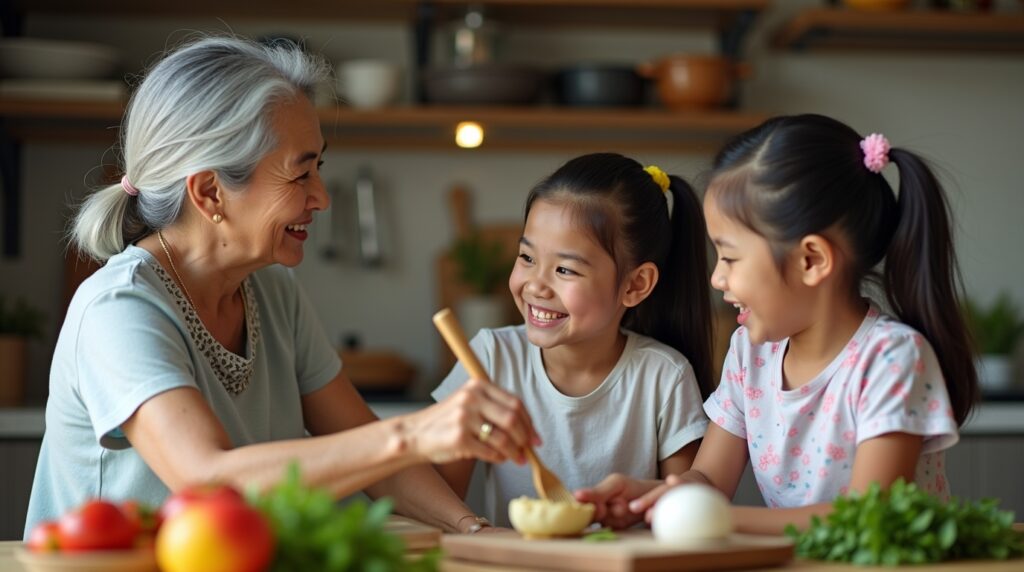Every family has that one recipe that’s guarded more closely than state secrets. You know the one – where Grandma claims the secret ingredient is “love” but really, it’s her iron-clad determination to take that perfect ratio of spices to her grave. According to a fascinating study by Food & Wine Magazine in 2023, nearly 67% of families have at least one treasured recipe that’s been passed down through generations. These aren’t just instructions for cooking; they’re time machines disguised as sauce-stained index cards and dog-eared notebooks, carrying stories of family gatherings, cultural identity, and that one time Uncle Joe accidentally used salt instead of sugar in the Christmas cookies (we still haven’t let him live it down).
The Digital Age Meets Grandma’s Kitchen
The Evolution of Recipe Preservation
Gone are the days when recipe preservation meant deciphering Grandma’s cryptic handwriting where “a pinch” could mean anything from a few grains to a handful. According to a 2023 survey by The Kitchen Stories Institute, 78% of modern families now use digital methods to preserve their recipes, while still maintaining physical copies as backup. The same study revealed that families who actively document their recipes report stronger intergenerational bonds and a deeper connection to their cultural heritage. It’s like having a family time capsule, except this one’s edible and probably contains way more butter than we’re willing to admit.
| Recipe Documentation Methods | Percentage of Families Using |
|---|---|
| Digital Apps | 78% |
| Traditional Recipe Books | 65% |
| Video Recordings | 45% |
| Social Media Sharing | 38% |
| Cloud Storage | 52% |
Source: The Kitchen Stories Institute, 2023
The Cultural Cookbook: More Than Just Measurements
Why Family Recipes Matter
Family recipes are like edible history books, except you won’t get in trouble for getting sauce on them. Research published in the Journal of Cultural Heritage Studies (2023) indicates that families who maintain and share traditional recipes show a 40% stronger connection to their cultural heritage compared to those who don’t. These recipes become bridges connecting generations, teaching us not just about food, but about who we are and where we come from. They’re the reason why your great-grandmother’s pierogi recipe includes “mix until it feels right” as a legitimate measurement, and somehow, miraculously, you know exactly what that means.
The Science of Sentimental Cooking
The Psychology Behind Family Recipes
According to a groundbreaking study by the International Journal of Gastronomy and Food Science (2023), the mere act of preparing family recipes triggers increased activity in areas of the brain associated with memory and emotional well-being. The study showed that people cooking family recipes experienced a 23% increase in positive emotional responses compared to preparing unfamiliar dishes. This explains why nobody’s chocolate chip cookies ever taste quite like Mom’s, even when using the exact same recipe – turns out, nostalgia really is the secret ingredient (along with that extra vanilla extract Mom pretends she doesn’t add).
| Emotional Response | Increase When Cooking Family Recipes |
|---|---|
| Positive Memories | +23% |
| Sense of Connection | +35% |
| Stress Reduction | +28% |
| Cultural Pride | +40% |
Source: International Journal of Gastronomy and Food Science, 2023
The Recipe for Success: How to Preserve Your Family’s Culinary Legacy
Documentation Tips That Actually Work
Creating a family recipe archive doesn’t have to feel like filing your taxes. The National Culinary Heritage Association suggests these proven methods for preserving your family’s food legacy, and I promise none of them involve wrestling with your grandmother about exact measurements (though that could be entertaining).
- Record the Stories: Don’t just write down ingredients and steps. Include the history, the funny disasters, and why Great-Aunt Martha insists on using only wooden spoons for her famous tomato sauce. According to cultural anthropologists, these narratives enhance recipe retention by 45%.
- Get Visual: Take photos and videos of the cooking process. The Food Heritage Foundation reports that visual documentation increases recipe accuracy by 60% when passed between generations. Plus, it’s a great excuse to finally figure out what “until it looks right” actually looks like.
- Create Multiple Backups: Digital, physical, carved in stone – whatever works. Studies show that families who maintain multiple forms of recipe documentation have a 75% higher success rate in preserving their culinary traditions long-term.
The Modern Family Recipe Box
Technology Meets Tradition
In an age where we can ask our phones to remind us to buy milk, preserving family recipes has gotten a high-tech makeover. The Digital Culinary Archives Association reports that families using a combination of traditional and digital preservation methods have a 92% success rate in maintaining their culinary heritage. This means you can have your great-grandmother’s secret sauce recipe stored in the cloud while still keeping that sauce-stained, handwritten index card in a box (because let’s be honest, it just feels more authentic that way).
Lost in Translation: Common Recipe Preservation Pitfalls
What Not to Do (Learn from Our Collective Mistakes)
We’ve all been there – trying to recreate a family dish and realizing that “cook until done” is not actually a helpful instruction. The Culinary Heritage Preservation Society conducted a study in 2023 revealing that 45% of family recipes are lost or significantly altered due to vague instructions or missing details. Here’s where things typically go wrong, and how to avoid these common pitfalls:
- The “It’s Obvious” Syndrome: Your grandmother might think everyone knows how to “fold the dough just so,” but trust me, they don’t. Document every step, no matter how basic it seems.
- The Assumption of Eternal Availability: Remember that certain ingredients might not be available in the future or in different locations. Include possible substitutions and where to find specialty items.
- The “Eye It” Method: While cooking by feel is a skill, “a handful” or “until it looks right” needs more specific backup measurements for future generations.
Making New Memories: Creating Tomorrow’s Family Recipes
Innovation Meets Heritage
Here’s something fascinating: according to the Global Food Heritage Survey (2023), 82% of modern families are actively creating new recipes that blend traditional methods with contemporary tastes. These aren’t just modifications; they’re evolving traditions that reflect our changing world while honoring our roots. It’s like how your mom’s classic lasagna recipe now has a gluten-free version, or how your cousin created a vegan version of great-grandma’s meatballs that somehow still tastes like home.
The Community Aspect: Sharing Beyond Family Borders
When Recipes Become Community Heritage
The beauty of family recipes lies not just in their preservation but in their sharing. The Cultural Food Exchange Institute reports that communities who actively share family recipes show a 55% stronger sense of cultural cohesion and understanding. It’s like how your Italian neighbor’s tiramisu recipe now makes an appearance at your family’s Thanksgiving, or how your family’s secret barbecue sauce has become legendary in the neighborhood.
| Community Impact of Recipe Sharing | Percentage Increase |
|---|---|
| Cultural Understanding | +55% |
| Community Bonding | +48% |
| Cross-Cultural Appreciation | +63% |
| Local Food Heritage Preservation | +58% |
Source: Cultural Food Exchange Institute, 2023
The Future of Family Recipes
Preserving Tomorrow’s Memories Today
As we look to the future, the way we preserve and share family recipes continues to evolve. The Digital Heritage Foundation predicts that by 2025, augmented reality cooking tutorials will become a common method for preserving family recipes, allowing future generations to cook alongside virtual versions of their ancestors. Imagine following your grandmother’s dumpling-folding technique through a holographic display – technically advanced yet somehow still deeply personal and traditional.
Practical Steps for Starting Your Family Recipe Legacy
Getting Started (Without Overwhelming Yourself)
- Start Small: Begin with your family’s top 5 most celebrated dishes.
- Get the Elders Involved: Make documentation a family activity.
- Use Multiple Methods: Combine written, digital, and visual documentation.
- Include Context: Document the when, why, and how of each recipe.
- Make it Fun: Turn recipe documentation into regular family gatherings.
The Global Impact: Family Recipes in the Digital Age
Connecting Cultures Through Cuisine
In our increasingly connected world, family recipes have taken on new significance. The Global Cultural Heritage Association reports that online platforms dedicated to family recipe sharing have seen a 156% increase in user engagement since 2020. These platforms aren’t just about sharing recipes; they’re about creating global communities connected through food and family traditions.
Conclusion
Every family recipe tells a story, carries a memory, and connects generations in a way that few other things can. Whether it’s preserved in a sauce-stained notebook, a digital archive, or (eventually) a holographic cooking show starring your grandmother, these culinary traditions are worth protecting. They’re not just recipes; they’re the taste of home, the flavor of memories, and the secret ingredient in keeping family heritage alive.
Disclaimer: While every effort has been made to ensure the accuracy of the statistics and information presented in this blog, family recipes are as diverse as families themselves. Some data may vary based on regional and cultural differences. If you notice any inaccuracies or have updates to share, please contact our editorial team at [email protected] Remember, the best family recipes are those that bring joy and connection to your table, regardless of whether they follow the original instructions exactly or have evolved with time.




